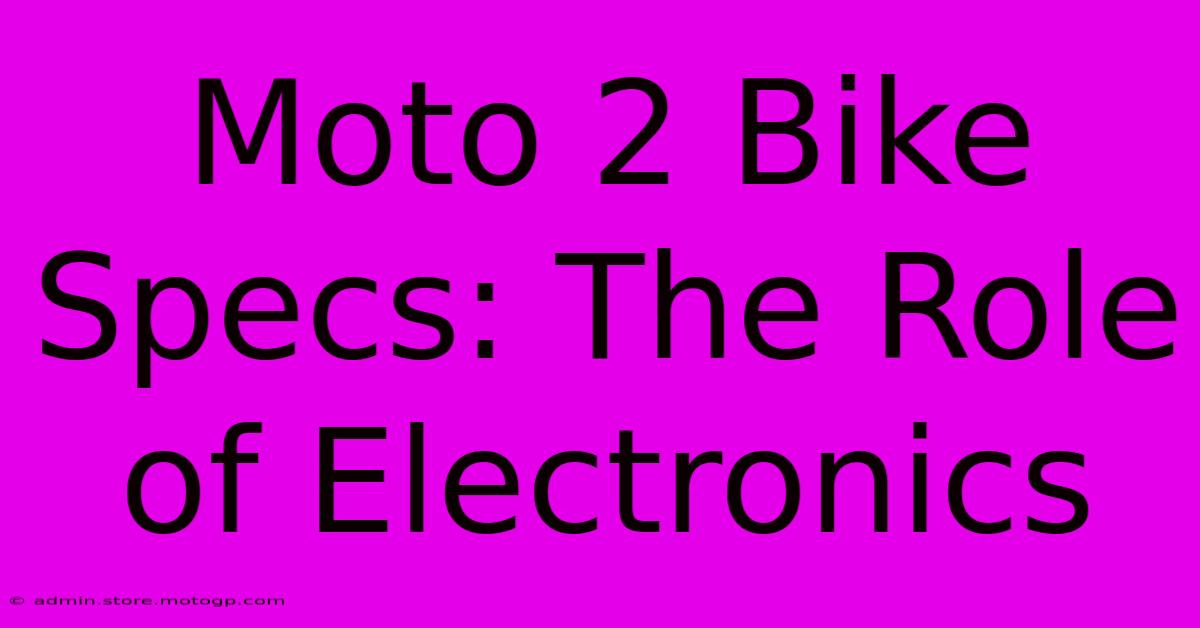Moto 2 Bike Specs: The Role Of Electronics

Table of Contents
Moto2 Bike Specs: The Role of Electronics
Moto2, the intermediate class of Grand Prix motorcycle racing, provides a fascinating blend of thrilling competition and advanced technological innovation. While the engines are standardized, the sophisticated electronics packages employed play a crucial role in rider performance and overall race outcomes. This article delves into the key electronic components and their impact on the Moto2 racing experience.
The Standardized Engine: A Level Playing Field
Before discussing the electronics, it's vital to understand the Moto2 framework. All teams use a standardized Triumph 765cc three-cylinder engine, ensuring a level playing field and focusing competition on chassis setup, rider skill, and, significantly, the mastery of electronics. This standardization makes the role of electronic control systems even more pronounced.
Key Electronic Systems in Moto2 Bikes
The sophistication of modern Moto2 electronics is impressive. Here are some key systems:
1. Engine Control Unit (ECU): The Brain of the Operation
The ECU is the central processing unit, managing numerous engine parameters. This includes:
- Engine Mapping: Adjusting fuel injection and ignition timing to optimize power delivery depending on track conditions and riding style. Different maps cater to various situations, like acceleration, cornering, and braking.
- Traction Control: Preventing wheel spin by reducing engine power when excessive slip is detected. This is crucial for maintaining stability and speed, especially during acceleration out of corners.
- Wheelie Control: Limiting the front wheel lift-off to prevent crashes and maintain consistent acceleration.
- Engine Braking Control: Managing engine braking to enhance stability and control during downshifts and braking maneuvers.
2. Inertial Measurement Unit (IMU): Sensing the World Around the Bike
The IMU is a critical sensor package that measures the bike's orientation and movement. It provides data on:
- Lean Angle: Crucial for sophisticated traction and wheelie control systems.
- Yaw Rate: Measures the rate of turning, helping with stability and cornering control.
- Pitch and Roll: Provides information about the bike's attitude, enhancing the effectiveness of other electronic systems.
3. Data Acquisition System (DAS): Analyzing Performance
The DAS gathers vast amounts of data from various sensors across the bike. This data is crucial for:
- Real-time analysis: Providing riders with immediate feedback on performance.
- Post-race analysis: Engineers use this data to fine-tune bike setup and improve performance.
- Telemetry: Allows the team to monitor the bike remotely and offer real-time support.
4. Anti-wheelie and Launch Control: Maximising Acceleration
These systems work in conjunction with the ECU and IMU to provide optimal acceleration. Anti-wheelie prevents front wheel lift-off, while launch control manages engine power and traction during starts, ensuring clean getaways.
The Impact on Rider Performance and Competition
The sophisticated electronics in Moto2 machines significantly impact rider performance and the competitive landscape. Here's how:
- Enhanced Rider Confidence: The electronic safety nets give riders greater confidence to push the limits of their machines.
- Improved Consistency: Consistent performance across varying track conditions and weather situations is crucial in Grand Prix racing.
- Reduced Rider Error: Electronics mitigate some of the potential errors that might occur due to human limitations.
- Increased Competition: With the engine standardized, the mastery of electronics becomes a key differentiator between successful and unsuccessful teams.
The Future of Electronics in Moto2
The evolution of electronics in Moto2 is a continuous process. We can expect even more sophisticated systems in the future, further blurring the line between man and machine, and delivering even more breathtaking races.
Keywords: Moto2, Moto2 Bike Specs, Motorcycle Electronics, ECU, IMU, DAS, Traction Control, Wheelie Control, Engine Braking Control, Triumph 765cc, Grand Prix Motorcycle Racing, Motorcycle Technology, Data Acquisition, Telemetry, Motorsports Technology
This article utilizes relevant keywords throughout the text, ensuring higher search engine visibility. The use of headings and subheadings improves readability and structure. The inclusion of bold and strong tags emphasizes key concepts. Remember to build backlinks to reputable sources for improved off-page SEO.

Thank you for visiting our website wich cover about Moto 2 Bike Specs: The Role Of Electronics. We hope the information provided has been useful to you. Feel free to contact us if you have any questions or need further assistance. See you next time and dont miss to bookmark.
Featured Posts
-
The Beauty Of Bike Racing Captured On Tv
Feb 19, 2025
-
Why Moto Gp Points Matter
Feb 19, 2025
-
Racing Motorcycles Innovation At Its Finest
Feb 19, 2025
-
Motorcycle Grand Prix Winners The Technology Behind The Triumph
Feb 19, 2025
-
Cota Parking Park Smart Race Happy
Feb 19, 2025
